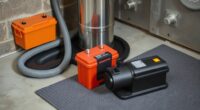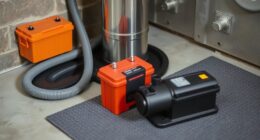Knowing the differences between headlamps and lanterns helps you choose the right light for your needs. Headlamps provide focused beams perfect for close-up work and offer hands-free convenience, while lanterns give broad, ambient light ideal for group settings. Consider power options, red light modes, and portability to stay safe and comfortable outdoors. Proper maintenance and testing guarantee your gear works when it matters most. Keep going to discover all the essential rules for making the most of your lighting options.
Key Takeaways
- Match headlamps for focused, long-distance tasks and lanterns for broad-area, ambient lighting based on activity needs.
- Prioritize hands-free features and secure mounting options for safety and convenience in both devices.
- Regularly test, inspect, and maintain batteries, switches, and seals to ensure reliable performance and safety.
- Use red light modes to preserve night vision and reduce glare during extended or night activities.
- Choose lightweight, portable devices, and practice proper storage and maintenance routines to prolong equipment lifespan.
Understand the Differences in Light Distribution and Intensity
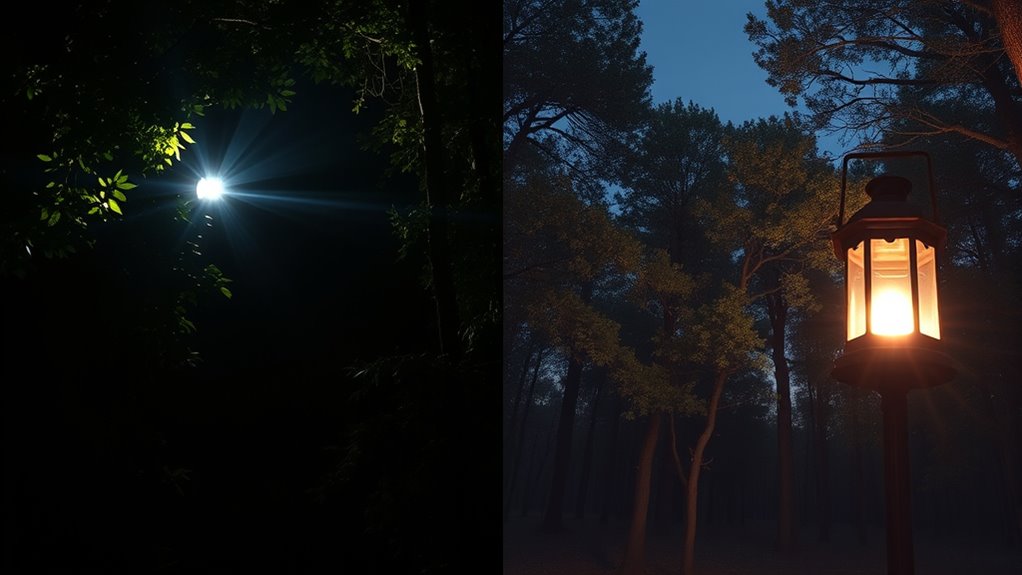
Understanding the differences in light distribution and intensity is essential when choosing between headlamps and lanterns. Headlamps typically have a focused beam, meaning the beam focus directs light straight ahead, ideal for close-up tasks or steering narrow trails. The light spread is narrow but adjustable, providing concentrated illumination without scattering light everywhere. Lanterns, on the other hand, produce a broader light spread, illuminating a wider area. Their intensity is generally softer but more dispersed, making them perfect for general campsite lighting or group visibility. Recognizing these differences helps you select the right device for your needs—whether you require a focused beam for precise work or a wide, even light for relaxing and socializing. Additionally, understanding light intensity and how it affects visibility can help you choose the most effective illumination for different activities.
Match Your Lighting Needs to the Proper Device
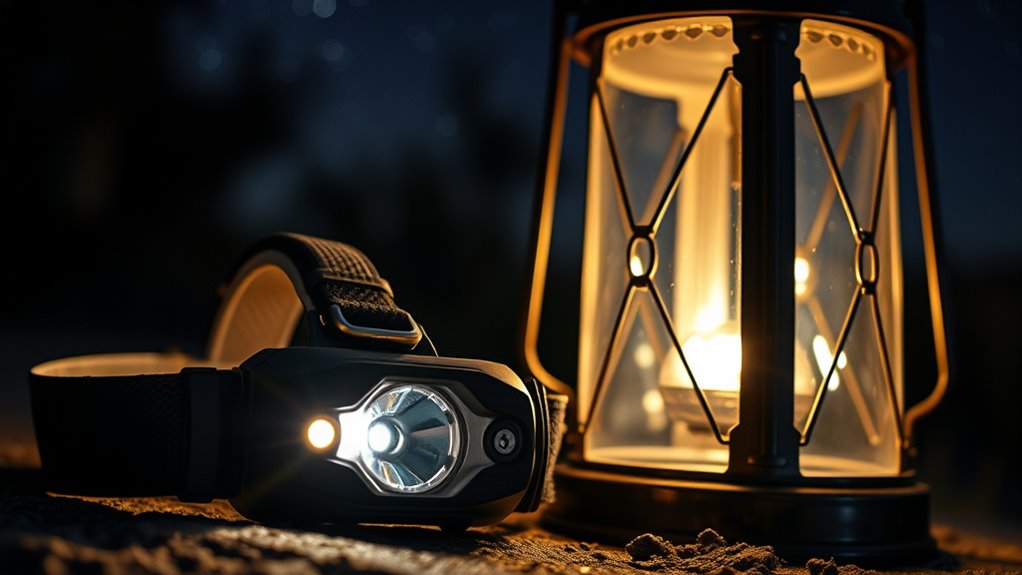
Choosing the right lighting device depends on what you need it for. If you require a focused beam to see far ahead, a headlamp with adjustable beam focus is ideal. It provides targeted illumination without disturbing others. For close-up tasks or group settings, a lantern with broader light distribution works better. Consider color options, too—some headlamps offer different colors to reduce glare or preserve night vision, while lanterns typically have softer, warmer tones. Think about how much light you need, whether you prefer hands-free operation, and if portability matters. Additionally, modern Kia Tuning options can enhance your vehicle’s lighting aesthetics and performance. Matching your lighting needs with the right device guarantees safety, efficiency, and comfort during your activities. Choose wisely based on the environment and task to get the most out of your lighting gear.
Prioritize Hands-Free Operation for Safety and Convenience

Opting for a headlamp or lantern that offers hands-free operation substantially enhances safety and convenience during your activities. With hands-free devices, you can focus on your task without juggling a flashlight in one hand. Choose headlamp accessories that improve comfort and stability, ensuring the light stays secure as you move. Prioritizing hands-free operation also reduces risks, like tripping or dropping gear, especially in low-light conditions. When selecting lanterns, consider designs that allow you to hang or mount them easily, providing versatile lighting options. While lantern aesthetics matter for style, functionality should take precedence, especially if safety is a concern. Hands-free devices make outdoor adventures, repairs, or camping safer and more efficient, keeping your hands free for what truly matters. Additionally, reviewing retail hours can help you plan your shopping trips to ensure availability of the best headlamp and lantern options.
Consider Power Sources and Battery Life for Extended Use

Since your activities might last for hours, it’s crucial to take into account the power sources and battery life of your headlamp or lantern. A higher battery capacity means longer use without frequent recharging. Consider charging options—USB rechargeability offers convenience, while replaceable batteries can be more dependable in remote areas. Look for devices with indicators that show remaining battery life to avoid surprises. Some headlamps and lanterns support power banks for extended sessions. Always check how long the device runs at different brightness levels. Keep spare batteries or a portable charger handy. Your choice impacts not just runtime but also ease of use in the field. Balance your needs with the device’s power features to ensure continuous illumination during your adventures. Additionally, selecting models with long-lasting batteries can significantly improve your experience in extended outings.
Use Red Light Modes to Protect Night Vision
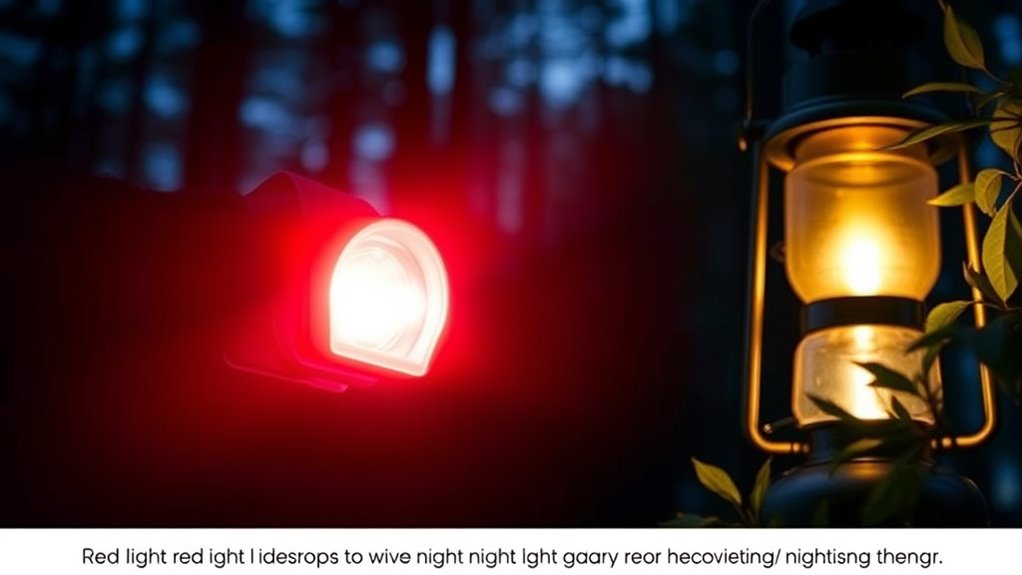
Using red light modes is essential for protecting your night vision during extended periods of illumination. Red light modes emit a softer, less intrusive light that minimizes eye strain and preserves your ability to see in darkness. When you switch to red light, your eyes don’t need to adjust as much, allowing you to maintain better night vision. This is especially useful when you’re steering or monitoring your surroundings without wanting to disrupt your adaptation to darkness. By using red light modes, you avoid the glare and harsh brightness that can quickly drain your night vision. Incorporating this feature into your headlamp or lantern ensures you stay alert and capable of seeing your environment clearly, even after long periods of use. Additionally, tuning your headlamp or lantern with features like red light modes can enhance your overall experience and effectiveness in low-light conditions.
Think About Portability and Weight for Your Activity
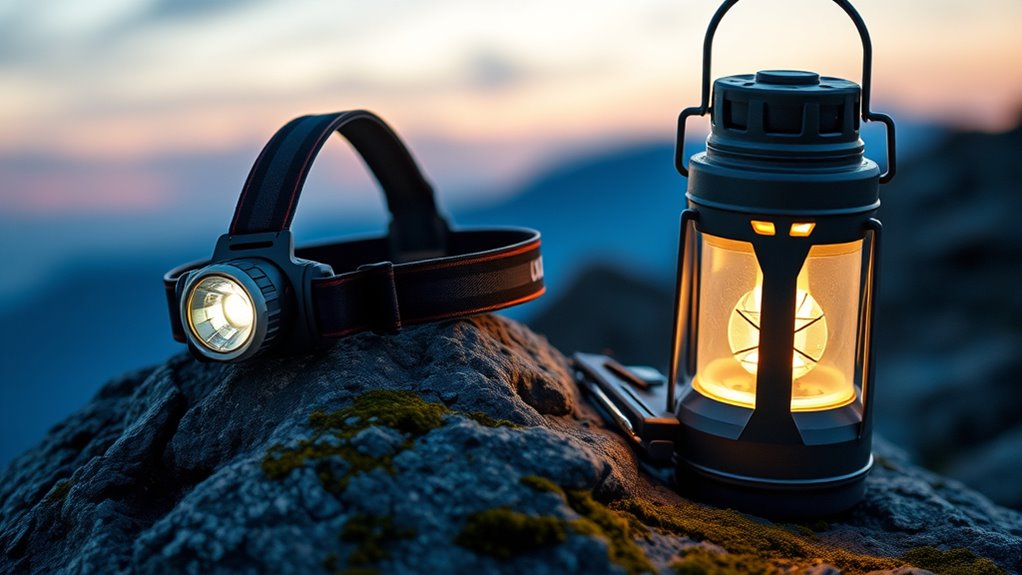
Considering the demands of your activity, it is crucial to evaluate how portable and lightweight your headlamp or lantern is. Weight considerations can profoundly impact comfort and endurance during extended use. Portability factors determine how easily you can carry or pack your lighting gear without hindering movement. For activities like hiking or camping, a lightweight headlamp might be preferable, while heavier lanterns could be suitable for stationary tasks. Keep in mind that bulky equipment may cause fatigue or inconvenience. To optimize your choice, consider these factors:
- Size and compactness
- Ease of packing or carrying
- Battery weight and life
- Material durability versus weight
- Overall ease of transport and setup
Ensuring your lighting device meets appliance quality standards can also influence its durability and performance during your activity.
Maintain and Test Your Equipment Before Critical Uses
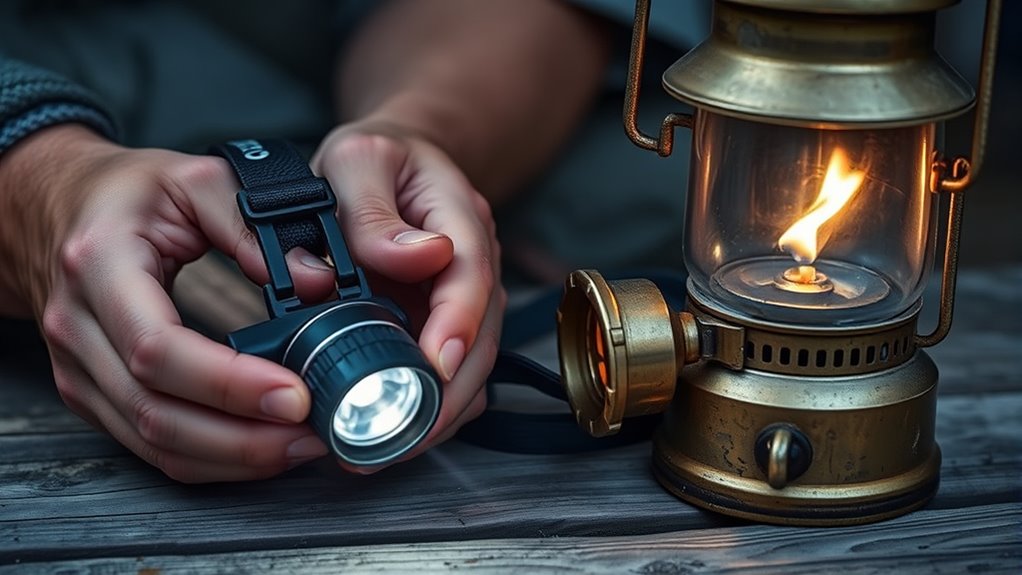
Before heading out, make sure your equipment is ready by checking the battery life and testing the light to verify it works properly. Regularly inspecting your headlamp or lantern for damage can prevent unexpected failures. Staying proactive with maintenance keeps your gear reliable when it matters most. Additionally, understanding the importance of color accuracy can help you select the right lighting tools for precise visibility in different environments.
Regularly Check Battery Life
Regularly checking your headlamp or lantern’s battery life is essential to guarantee it’s ready when you need it most. Keeping an eye on battery longevity helps prevent unexpected failures during critical moments. Proper power management ensures your device operates efficiently and lasts longer. To do this effectively:
- Test batteries before each outing or use
- Use a battery tester for accurate readings
- Replace old batteries proactively
- Keep spare batteries in your kit
- Store equipment in cool, dry places to maintain battery life
- Be aware of battery specifications and ensure your batteries meet the recommended standards to maximize performance.
Test Light Functionality Often
Checking your headlamp or lantern before heading out guarantees it works properly when you need it most. Regularly testing the light functionality ensures you’re not caught in the dark unexpectedly. Turn on your device and verify all modes and brightness levels, especially if it has color options like white, red, or green. This helps confirm the bulb or LEDs are working smoothly. Consider size considerations too—compact headlamps might be easier to carry but can be more delicate, so testing them often is key. For lanterns, ensure the switch and battery contacts are functioning correctly. Doing this simple check keeps your equipment reliable, prevents surprises, and ensures you’re prepared for any situation. Make testing part of your routine before every trip or critical use. Routine maintenance of your gear is essential to ensure long-term reliability and safety.
Inspect for Damage Regularly
Inspecting your headlamp or lantern for damage is essential to guarantee it functions reliably when you need it most. Regular checks help identify issues early, preventing failures during critical moments. Look for cracks, corrosion, or loose parts that could affect performance. Ensure batteries are properly maintained to avoid leaks and power loss. Follow storage tips by keeping your equipment in a cool, dry place, and remove batteries if unused for extended periods. Test the switch and bulb or LEDs to confirm they work correctly. Check for any frayed cords or damaged seals that might let moisture in. Proper inspection prolongs your gear’s life, saves you from unexpected failures, and guarantees your lighting is dependable when it matters most. Additionally, verifying your power sources helps ensure your devices stay charged and ready for use.
Frequently Asked Questions
How Do Headlamps and Lanterns Compare in Durability and Weather Resistance?
Headlamps typically offer better durability and weather resistance thanks to high weatherproof ratings and sturdy materials like reinforced plastics and rubber seals. Lanterns, while generally durable, may have lower ratings, making them less ideal in harsh conditions. You should check the weatherproof ratings and material durability before choosing, ensuring your gear withstands rain, mud, and rough handling while providing reliable lighting in outdoor adventures.
Are There Safety Standards or Certifications I Should Look For?
You should definitely look for safety certifications and quality standards when choosing lighting gear. Don’t risk your safety by ignoring these vital indicators; they guarantee the products meet essential safety and durability benchmarks. Certifications like UL or CE signal reliability, giving you peace of mind in critical situations. Always check for these standards before buying—your safety depends on it, especially in unpredictable outdoor conditions.
How Do I Choose the Right Brightness Level for Different Activities?
You should choose your brightness level based on the activity, using brightness adjustment features for activity-specific lighting. For detailed tasks like reading or map navigation, opt for a lower lumen setting to avoid glare. For outdoor activities like hiking or camping, select higher brightness levels to illuminate larger areas. Adjust the brightness as needed to conserve battery life and ensure safety, making certain you’re always prepared for different situations.
Can I Use Rechargeable Batteries With Both Devices?
Yes, you can use rechargeable batteries with both headlamps and lanterns, but check their battery compatibility first. Many devices support common rechargeable types like NiMH or lithium-ion batteries. Also, consider the charging methods—some headlamps and lanterns have built-in rechargeable batteries, while others require removable ones. Always follow the manufacturer’s instructions to guarantee safe use and peak performance, and recharge batteries as needed for continuous illumination.
What Maintenance Is Required to Extend the Lifespan of My Lighting Equipment?
Sure, you can extend your lighting gear’s lifespan with simple maintenance. Keep an eye on battery longevity by removing batteries when not in use to prevent corrosion. Clean lenses regularly with a soft cloth to avoid reduced brightness. Ironically, neglecting these steps might make your equipment last just long enough for you to forget you ever needed it. Proper care guarantees your headlamp or lantern stays bright when you need it most.
Conclusion
By mastering these rules, you’ll transform into an unstoppable lighting legend, never again stumbling in the dark or losing precious time. Your headlamp or lantern will become an extension of yourself, illuminating every step with superhero precision. Skip these tips, and you risk being stranded in the shadows, helpless and lost. Embrace these guidelines, and watch your adventures shine brighter than ever—because when it comes to lighting, there’s no room for guesswork or failure.

